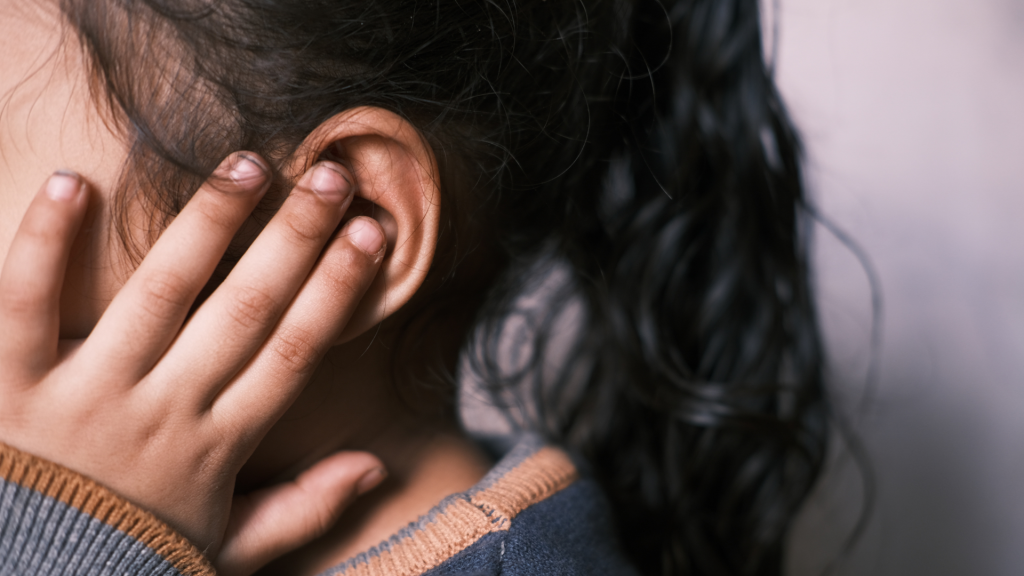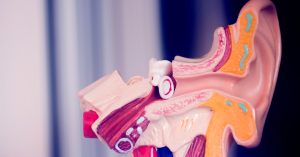Introduction
You’re not in pain, but something feels off. Your ears feel muffled, your hearing seems dulled, and there’s that strange sensation of pressure—like you’re underwater or on an airplane that never quite leveled out. It’s not painful… but it’s definitely annoying. So, what’s going on?
This odd feeling—often described as “ear fullness” or “clogged ears”—is surprisingly common. And while it’s usually harmless, it can leave you feeling frustrated, distracted, and wondering if something’s wrong.
The tricky part? Because there’s no pain, many people brush it off or try risky DIY methods to “pop” or clear their ears. But understanding why your ears feel full is the first step to getting real, lasting relief—without making things worse.
In this guide, we’ll break down the most common reasons your ears feel clogged even when they don’t hurt, how to know when it’s serious, safe home remedies, and how to stop it from coming back in the future.
Let’s clear things up—literally.
Understanding the Full-Ear Sensation
What “Clogged” Really Means
When people say their ears feel “clogged,” they’re usually describing a sense of pressure or blockage in the ear canal, even if nothing is physically stuck there. It can feel like you’re wearing invisible earplugs or like your ears won’t “pop” after a flight. This sensation is known as aural fullness—and while it can be unsettling, it doesn’t always mean something is seriously wrong.
Your ear is made up of three main parts: the outer, middle, and inner ear. The sensation of fullness often stems from issues in the middle ear, especially where pressure is regulated by the Eustachian tubes—tiny canals that connect your middle ear to the back of your nose and throat.
When these tubes don’t open and close properly, pressure builds up behind the eardrum, causing a sensation of fullness, sometimes accompanied by mild hearing changes or a crackling sound. But notably—no pain.
So if there’s no throbbing, sharp ache, or fever, you’re likely not dealing with an ear infection. Instead, you might be experiencing a mechanical or pressure-related issue.
Why It Happens Without Pain
Pain typically signals inflammation or infection. But in many cases of ear fullness, the problem is more about fluid imbalance, pressure changes, or blockage—not irritation or infection. That’s why you may feel “off” without feeling “sick.”
Common reasons it can occur without pain include:
- Subtle pressure differences in your environment
- Recent allergies or sinus congestion
- Wax or fluid buildup that isn’t severe
- Temporary Eustachian tube dysfunction after a cold
The bottom line? Ear fullness doesn’t require pain to be a real issue. It’s your body’s way of signaling that something’s off with the ear’s normal function—even if it’s not an emergency.
The good news? Most causes of this sensation are temporary, manageable, and often preventable once you understand what’s happening.
Common Causes of Ear Fullness Without Pain
Earwax Buildup, Eustachian Tube Dysfunction, and More
A full or clogged ear without pain often has one or more of these common, non-emergency causes:
Earwax Buildup (Cerumen Impaction)
Earwax is your body’s natural defense—it traps dust, dirt, and microbes. But too much of it, or wax pushed deep into the canal (often by cotton swabs), can block sound and create that “plugged” feeling. It’s one of the most common reasons people feel ear fullness without actual pain.
Look out for:
- Muffled hearing
- A feeling like something is “stuck”
- Occasional popping or crackling
Fortunately, this can usually be resolved safely with ear drops, irrigation kits, or professional cleaning.
Eustachian Tube Dysfunction (ETD)
As discussed earlier, the Eustachian tubes regulate pressure in your middle ear. When they’re inflamed or blocked—often due to allergies, sinus congestion, or a recent cold—you get that “pressure bubble” feeling.
Symptoms of ETD include:
- Fullness or pressure in one or both ears
- Hearing that fluctuates
- Clicking or popping when swallowing or yawning
ETD is often temporary and improves as inflammation subsides.
Sudden Altitude or Pressure Changes
Have you been flying, scuba diving, driving through mountains, or riding an elevator? Rapid pressure changes can prevent your ears from equalizing properly. If your ears didn’t “pop” as they should’ve, you’re likely feeling the after-effects.
It’s harmless, but annoying—and usually resolves within hours or a couple of days with simple techniques like swallowing, yawning, or using the Valsalva maneuver (gently blowing with your nose pinched shut).
Temporary Fluid Buildup
After a cold or allergy flare-up, fluid can linger in the middle ear even after symptoms improve. You might feel like you’re still congested, even if your nose is clear.
This trapped fluid can cause:
- A subtle, spongy feeling
- Ear crackling sounds
- Mild balance issues (in some cases)
It typically resolves on its own, but persistent fluid may require evaluation.
TMJ (Jaw Joint) Issues
Believe it or not, problems with your temporomandibular joint (TMJ) can radiate into your ears. Tension, grinding, or misalignment can create a “clogged” or “pressure” sensation—often mistaken for an ear issue.
Other possible causes include:
- Barotrauma (mild pressure-related injury)
- Inner ear pressure disorders (rare)
- Acoustic exposure or vibration sensitivity
Environmental and Lifestyle Triggers
Sometimes, the cause isn’t internal—it’s external.
Triggers can include:
- Wearing earbuds or headphones for long periods
- Being in noisy environments for extended time
- Dehydration or sinus dryness
- Smoking or air pollution exposure
These all influence how your ears manage pressure, fluid, and balance—especially if you’re sensitive.
The key takeaway? Most of the time, this sensation is treatable and non-threatening. And the better you understand the root cause, the faster you can fix it.

When to Worry and When to Wait
Red Flags vs Normal Sensations
Most of the time, ear fullness without pain is just a temporary nuisance. But there are a few key signs that could indicate something more serious and warrant a visit to your healthcare provider.
Red flags include:
- Fullness that lasts more than 2 weeks with no improvement
- Sudden, unexplained hearing loss in one or both ears
- Feeling of fullness accompanied by dizziness, nausea, or imbalance
- A sensation of your ear “clicking” or pulsing in rhythm with your heartbeat (could indicate vascular issues)
- Drainage, discharge, or bleeding from the ear (even if pain-free)
- A feeling of “blocked ear” with a recent head injury, pressure trauma, or loud noise exposure
In these cases, it’s not just about discomfort—it could be a sign of an underlying medical condition such as:
- Sensorineural hearing loss (sudden or progressive)
- Ménière’s disease or other inner ear disorders
- TMJ dysfunction requiring dental or physical therapy treatment
- A mild or “silent” middle ear infection (especially in kids or elderly adults)
If your symptoms are mild but persistent, it’s better to get a professional opinion than wait and worry. A hearing test or simple otoscopic exam can rule out issues quickly and painlessly.
How Long Is Too Long?
Ear fullness that comes and goes or follows a pattern (like after flying or during allergy season) is usually nothing to stress about. But if that sensation:
- Lingers beyond 10–14 days
- Is getting worse instead of better
- Interferes with your hearing, balance, or daily focus
…it’s time to act.
Even if you’re not in pain, your ears are sending you a message. And early detection is always easier—and safer—than trying to fix things down the road.
If you’ve tried home remedies and nothing’s working, don’t keep guessing. A visit to your audiologist, ENT (ear, nose, throat doctor), or primary care provider can help identify the cause and give you the right tools to clear the clog for good.
DIY Relief and Safe At-Home Remedies
Natural Techniques to Clear the Feeling
Before you reach for risky tools or fall into a YouTube rabbit hole, know this: many cases of ear fullness can be relieved gently, safely, and effectively at home—if you know what you’re doing.
Here are the top tried-and-true methods:
Swallowing, Yawning, or the Valsalva Maneuver
These help open your Eustachian tubes and equalize pressure in your ears—especially after flights, changes in elevation, or sinus congestion.
- Swallow frequently (gum, water, candy)
- Yawn deeply to stretch the jaw and relieve pressure
- Valsalva technique: Close your mouth, pinch your nose, and gently exhale (don’t blow too hard!)
Do not use this if you have a cold or infection, as it may worsen symptoms.
Warm Compress or Steam Inhalation
If sinus congestion or ETD is behind the pressure, applying warmth can relax tissues and promote drainage.
- Use a warm cloth over the affected ear
- Try steamy showers or bowl inhalation with essential oils (eucalyptus, peppermint)
This is especially soothing during allergy flare-ups or post-cold recovery.
Over-the-Counter Remedies
For mild swelling or congestion, OTC products may help:
- Decongestants (oral or nasal spray) can open sinus and Eustachian tube pathways
- Saline nasal rinses help reduce inflammation
- Ear drops (mineral oil or hydrogen peroxide) can soften stubborn wax—but only if your eardrum is intact and you don’t suspect an infection
Always follow product directions and consult a pharmacist or provider if unsure.
Gentle Head Positioning
Sometimes shifting your head gently or lying on one side can help drain trapped fluid or rebalance internal pressure.
- Lie on your side with the full ear facing down
- Tilt your head side to side while sitting or lying down slowly
You might hear a small “pop” or sense a sudden change—that’s usually a sign the pressure has released.
What Not to Do to Your Ears
It’s just as important to know what to avoid. These are common mistakes that can make your ear fullness worse—or even dangerous:
Don’t use cotton swabs, hairpins, or fingers to dig inside your ear
Don’t use ear candles—they are not medically proven and can cause burns or blockages
Don’t force any “popping” technique repeatedly or aggressively
Don’t insert any liquid or tool into your ear if you have a history of ear infections, tubes, or a ruptured eardrum
If you’re unsure—stop and ask a pro. Gentle care and patience go a long way.

Professional Treatments and Prevention Tips
When to See a Specialist
If your ear fullness has lingered longer than two weeks, keeps coming back, or is affecting your hearing or focus—it’s time to call in the pros. The good news? Relief is often just one appointment away.
Here’s who you might see and what to expect:
Primary Care Provider
They can:
- Look for wax impaction or infection
- Suggest medications (like decongestants or steroids)
- Refer you to a specialist if needed
ENT (Ear, Nose, Throat) Specialist
Also called an otolaryngologist, an ENT can:
- Assess Eustachian tube dysfunction
- Treat fluid buildup or pressure problems
- Diagnose TMJ or more complex issues
- Perform ear cleaning or pressure equalization procedures
Audiologist
If you’re noticing hearing changes with that full feeling, an audiologist can:
- Conduct hearing tests
- Identify early signs of hearing loss
- Recommend hearing protection or sound therapy if needed
These professionals use otoscopes, tympanometers, and hearing evaluations to pinpoint the issue—no guessing, no assumptions. Getting answers can offer peace of mind and better quality of life.
How to Keep That Full Feeling From Coming Back
Once you’ve cleared the fullness, it’s smart to prevent it from happening again. Here are habits and tips that help:
Stay Hydrated & Humidified
Dry environments dry out your nasal and ear tissues. Use a humidifier, drink plenty of water, and take breaks from dry air (especially in winter or on airplanes).
Manage Allergies & Sinus Health
Allergic rhinitis is a top cause of ETD. Stay on top of medications, nasal sprays, and reduce allergen exposure—especially during seasonal changes.
Skip the Swabs
Let your ears clean themselves naturally, or have a professional remove wax when needed. Avoid pushing anything into your ear canal.
Equalize Pressure Gently
Use the yawning or swallowing technique during flights, elevators, or diving. If you travel often, consider filtered earplugs designed for pressure regulation.
Take Noise Breaks
Avoid prolonged exposure to loud environments or earbuds—your ears need time to rest and recover.
And of course, always listen to your body. If your ears are giving you signals, respond with care—not neglect or overreaction.
You don’t need to live with that constant “plugged up” feeling. Relief is within reach—with the right guidance, good habits, and a little self-awareness.

Conclusion: You’re Not Alone—And You’re Not Stuck
A clogged ear without pain can be confusing, frustrating, and even distracting—but it doesn’t have to be a mystery. Whether it’s pressure buildup, wax, sinus issues, or a simple reaction to your environment, the good news is: most cases are treatable, manageable, and temporary.
Now that you understand what might be causing that full-ear sensation, you’re already a step ahead. You know when to try a home remedy, when to wait it out, and when it’s time to seek help. And best of all, you know what not to do—no more risky poking or guessing games.
So the next time your ears feel full but don’t hurt, don’t panic. Listen to your body. Try the gentle methods. Track your symptoms. And if it sticks around longer than it should—call a professional.
Your hearing and ear health deserve attention, even when it’s not an emergency.
Because clear hearing isn’t just about sound—it’s about peace of mind.
Frequently Asked Questions
Why do my ears feel clogged even though I’m not sick?
Clogged ears can happen without illness due to factors like earwax buildup, pressure changes, allergies, or Eustachian tube dysfunction. Even changes in altitude or humidity can trigger the sensation without causing pain or infection.
How long should I wait before seeing a doctor about ear fullness?
If the feeling lasts more than 10–14 days, gets worse, or is paired with hearing loss, dizziness, or ear discharge, it’s time to see a healthcare provider. Early evaluation can prevent complications and offer faster relief.
Can stress or anxiety cause ears to feel full?
Yes, in some cases. TMJ tension caused by stress (clenching or grinding teeth) can affect the ear and create a sensation of pressure or fullness. Anxiety can also heighten awareness of subtle sensations.
Are clogged ears always caused by earwax?
No. While earwax is a common cause, many other factors can lead to fullness—like sinus congestion, fluid in the middle ear, or pressure imbalance. Not all ear fullness is visible or solvable with wax removal.
Is it okay to use cotton swabs or ear candles to clear the feeling?
No. Cotton swabs can push wax deeper or damage your ear canal, and ear candles are unsafe and ineffective. Stick to safe methods like warm compresses, steam, or professional cleaning if needed.
Can I fly or travel with clogged ears?
Yes, but use caution. Swallowing, yawning, and using filtered earplugs can help equalize pressure. If you’re congested or have Eustachian tube issues, speak with your doctor before flying to avoid discomfort or barotrauma.
Disclaimer
This article is for informational purposes only and is not a substitute for professional medical advice, diagnosis, or treatment. If you are concerned about your hearing or ear health, please consult a qualified healthcare provider.






